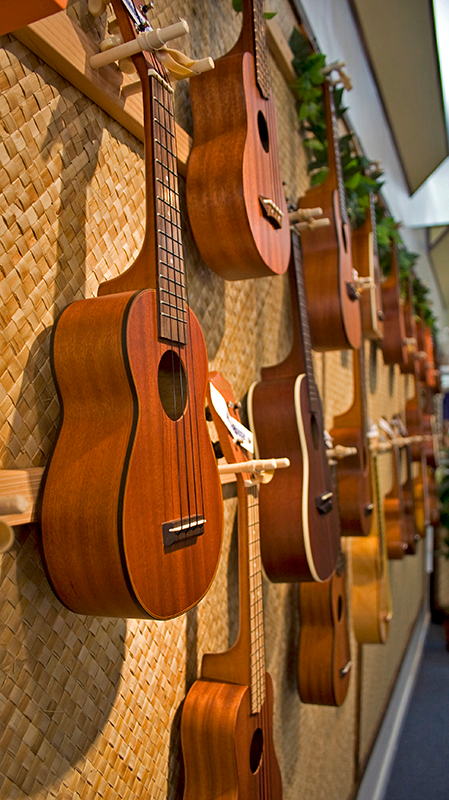le titre du livre — 2. The object
2
The object

Construction
The ukulele is generally made of wood, though variants have been composed partially or entirely of plastic or other materials. Cheaper ukuleles are generally made from plywood or laminated woods, in some cases with a soundboard of a tonewood such as spruce. More expensive ukuleles are made of solid hardwoods such as mahogany. The traditionally preferred wood for ukuleles is a type of acacia endemic to Hawaii, called koa.
Typically, ukuleles have a figure-eight body shape similar to that of a small acoustic guitar. They are also often seen in nonstandard shapes, such as cutaway and oval, usually called a "pineapple" ukulele (see image below), invented by the Kamaka Ukulele company, or a boat-paddle shape, and occasionally a square shape, often made out of an old wooden cigar box.
These instruments usually have four strings; some strings may be paired in courses, giving the instrument a total of six or eight strings (primarily for greater strumming volume.) The strings themselves were originally made of catgut. Modern ukuleles use nylon polymer strings, with many variations in the material, such as fluorocarbon, aluminium (as winding on lower-pitched strings), and Nylgut.
Instruments with six or eight strings in four courses are often called taropatches, or taropatch ukuleles. They were once common in a concert size, but now the tenor size is more common for six-string taropatch ukuleles. The six-string, four-course version, has two single and two double courses, and is sometimes called a lili'u, though this name also applies to the eight-string version. Eight-string baritone taropatches exist, and, 5-string tenors have also been made.
Types and sizes
Common types of ukuleles include soprano (standard ukulele), concert, tenor, and baritone. Less common are the sopranino (also called piccolo, bambino, or "pocket uke"), bass, and contrabass ukuleles. Other types of ukuleles include banjo ukuleles and electric ukuleles. Of the standard ukuleles, the soprano, often called "standard" in Hawaii, is the second-smallest and was the original size. The concert size was developed in the 1920s as an enhanced soprano, slightly larger and louder with a deeper tone. Shortly thereafter, the tenor was created, having more volume and deeper bass tone. The baritone (resembling a smaller tenor guitar) was created in the 1940s, and the contrabass and bass are recent innovations (2010 and 2014, respectively).
|
Type |
Alternate |
Typical |
Scale |
Frets |
Range |
Common |
Alternate |
|---|---|---|---|---|---|---|---|
|
|
piccolo, sopranino, sopranissimo |
16 in (41 cm) |
11 in (28 cm) |
10–12 |
G4–D6 (E) |
D5 G4 B4 E5 |
C5 F4 A4 D5 |
|
Soprano |
standard, ukulele |
21 in (53 cm) |
13 in (33 cm) |
12–15 |
C4–A5 (C) |
G4 C4 E4 A4 |
A4 D4 F4 B4 |
|
Concert |
alto |
23 in (58 cm) |
15 in (38 cm) |
15–18 |
C4–C6 (D) |
G4 C4 E4 A4 |
G3 C4 E4 A4 |
|
Tenor |
taro patch, Liliu |
26 in (66 cm) |
17 in (43 cm) |
17–19 |
G3–D6 (E) |
G4 C4 E4 A4
("High G") |
D4 G3 B3 E4 |
|
Baritone |
bari, bari uke, taropatch |
29 in (74 cm) |
19 in (48 cm) |
18–21 |
D3–A5 (C) |
D3 G3 B3 E4 |
C3 G3 B3 E4 |
|
Bass |
30 in (76 cm) |
20 in (51 cm) |
16–18 |
E2–B4 (C) |
E2 A2 D3 G3 |
||
|
Contrabass |
U-Bass, Rumbler |
32 in (81 cm) |
21 in (53 cm) |
16 |
E1–B3 |
E1 A1 D2 G2 |
D1 A1 D2 G2 ("Drop D") |
